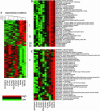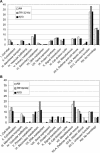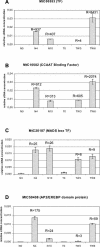Expression profiling in Medicago truncatula identifies more than 750 genes differentially expressed during nodulation, including many potential regulators of the symbiotic program
- PMID: 15466239
- PMCID: PMC523376
- DOI: 10.1104/pp.104.043612
Expression profiling in Medicago truncatula identifies more than 750 genes differentially expressed during nodulation, including many potential regulators of the symbiotic program
Abstract
In this study, we describe a large-scale expression-profiling approach to identify genes differentially regulated during the symbiotic interaction between the model legume Medicago truncatula and the nitrogen-fixing bacterium Sinorhizobium meliloti. Macro- and microarrays containing about 6,000 probes were generated on the basis of three cDNA libraries dedicated to the study of root symbiotic interactions. The experiments performed on wild-type and symbiotic mutant material led us to identify a set of 756 genes either up- or down-regulated at different stages of the nodulation process. Among these, 41 known nodulation marker genes were up-regulated as expected, suggesting that we have identified hundreds of new nodulation marker genes. We discuss the possible involvement of this wide range of genes in various aspects of the symbiotic interaction, such as bacterial infection, nodule formation and functioning, and defense responses. Importantly, we found at least 13 genes that are good candidates to play a role in the regulation of the symbiotic program. This represents substantial progress toward a better understanding of this complex developmental program.
Figures



References
-
- Ardourel M, Demont N, Debelle F, Maillet F, de Billy F, Prome JC, Denarie J, Truchet G (1994) Rhizobium meliloti lipooligosaccharide nodulation factors: different structural requirements for bacterial entry into target root hair cells and induction of plant symbiotic developmental responses. Plant Cell 6: 1357–1374 - PMC - PubMed
-
- Baudouin E, Frendo P, Le Gleuher M, Puppo A (2004) A Medicago sativa haem oxygenase gene is preferentially expressed in root nodules. J Exp Bot 55: 43–47 - PubMed
-
- Ben Amor BB, Shaw SL, Oldroyd GE, Maillet F, Penmetsa RV, Cook D, Long SR, Denarie J, Gough C (2003) The NFP locus of Medicago truncatula controls an early step of Nod factor signal transduction upstream of a rapid calcium flux and root hair deformation. Plant J 34: 495–506 - PubMed
-
- Brechenmacher L, Weidmann S, Van Tuinen D, Chatagnier O, Gianinazzi S, Franken P, Gianinazzi-Pearson V (2004) Expression profiling of up-regulated plant and fungal genes in early and late stages of Medicago truncatula-Glomus mosseae interactions. Mycorrhiza 14: 253–262 - PubMed
-
- Budelier KA, Smith AG, Gasser CS (1990) Regulation of a stylar transmitting tissue-specific gene in wild-type and transgenic tomato and tobacco. Mol Gen Genet 224: 183–192 - PubMed
Publication types
MeSH terms
Substances
LinkOut - more resources
Full Text Sources
Molecular Biology Databases

